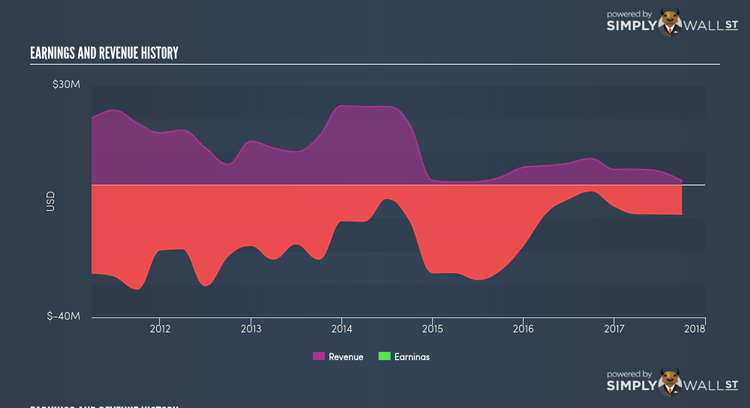How Should Investors Feel About Odyssey Marine Exploration Inc’s (NASDAQ:OMEX) CEO Pay?

Leading Odyssey Marine Exploration Inc (NASDAQ:OMEX) as the CEO, Mark Gordon took the company to a valuation of $31.29M. Recognizing whether CEO incentives are aligned with shareholders is a crucial part of investing. Incentives can be in the form of compensation, which should always be structured in a way that promotes value-creation to shareholders. I will break down Gordon’s pay and compare this to the company’s performance over the same period, as well as measure it against other US CEOs leading companies of similar size and profitability. Check out our latest analysis for Odyssey Marine Exploration
What has OMEX’s performance been like?
Earnings is a powerful indication of OMEX’s ability to invest shareholders’ funds and generate returns. Therefore I will use earnings as a proxy of Gordon’s performance in the past year. Recently, OMEX released negative earnings of -$8.8M , which is a further decline from prior year’s loss of -$1.7M. Additionally, on average, OMEX has been loss-making in the past, with a 5-year average EPS of -$2.65. During times of negative earnings, the company may be incurring a period of reinvestment and growth, or it can be an indication of some headwind. Regardless, CEO compensation should emulate the current state of the business. From the latest report, Gordon’s total remuneration rose by 17.82% to $1,180,784. Furthermore, Gordon’s pay is also made up of 17.17% non-cash elements, which means that variabilities in OMEX’s share price can affect the true level of what the CEO actually receives.
Is OMEX overpaying the CEO?
Even though there is no cookie-cutter approach, as remuneration should be tailored to the specific company and market, we can fashion a high-level base line to see if OMEX deviates substantially from its peers. This outcome can help shareholders ask the right question about Gordon’s incentive alignment. On average, a US small-cap has a value of $1B, produces earnings of $96M, and pays its CEO at roughly $2.7M annually. Typically I would look at market cap and earnings as a proxy for performance, however, OMEX’s negative earnings reduces the usefulness of my formula. Looking at the range of compensation for small-cap executives, it seems like Gordon is being paid within the bounds of reasonableness. Overall, even though OMEX is unprofitable, it seems like the CEO’s pay is sound.
What this means for you:
Are you a shareholder? Hopefully this article has given you insight on how shareholders should think about OMEX’s governance policies such as CEO pay. As an investor, you have the right to understand how the board thinks about management incentives, and also the right to vote for and against substantial CEO pay changes. Governance is a big factor in investing, and I encourage you to dig deeper into those that represent your voice on the board. To find out more about OMEX’s governance, look through our infographic report of the company’s board and management.
Are you a potential investor? In order to determine whether or not you should invest in OMEX, your thesis should be built on fundamentals. Even though CEO pay isn’t technically a key concern, it could serve as an indication as to how board members align incentives and how they think about setting policies. These issues directly impacts how OMEX makes money, and factors impacting your return on investment. To research more about these fundamentals, I recommend you check out our simple infographic report on OMEX’s financial metrics.
PS. If you are not interested in Odyssey Marine Exploration anymore, you can use our free platform to see my list of over 50 sustainable companies producing great returns.
To help readers see pass the short term volatility of the financial market, we aim to bring you a long-term focused research analysis purely driven by fundamental data. Note that our analysis does not factor in the latest price sensitive company announcements.
The author is an independent contributor and at the time of publication had no position in the stocks mentioned.

